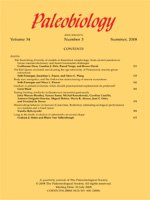Recent phylogenetic studies of Paleozoic gastropods show the classification provided by the Treatise on Invertebrate Paleontology to include numerous highly polyphyletic taxa. Here we test whether this classification reflects limits on the range of possible designs, general architectural constraints, or common functional solutions for Paleozoic gastropods. Our test evaluates whether superfamilial/subordinal level archetypes as defined by the Treatise evolved more frequently than expected among 626 Late Cambrian–Middle Devonian species. Using a previously established phylogeny and five general shell features (spire angle, exhalent current position, base angle, umbilical width, and apertural inclination) we show that there are fewer gastropod morphotypes than expected given the frequency of change in these features. This is true even after accounting for architectural constraints implied by the data. Moreover, the most common morphotypes include significantly more species and evolved significantly more times than expected. These results imply a set of architectural attractors for lower–middle Paleozoic gastropods, consistent with ecomorphological theory that particular morphotypes are best suited for particular lifestyles. Thus, the Treatise classifications likely reflect these ecomorphological patterns within subclades rather than phylogenetic patterns.
How to translate text using browser tools
1 March 2006
Patterns of convergence in general shell form among Paleozoic gastropods
Peter J. Wagner,
Douglas H. Erwin
ACCESS THE FULL ARTICLE
<
Previous Article
|

Paleobiology
Vol. 32 • No. 2
March 2006
Vol. 32 • No. 2
March 2006




